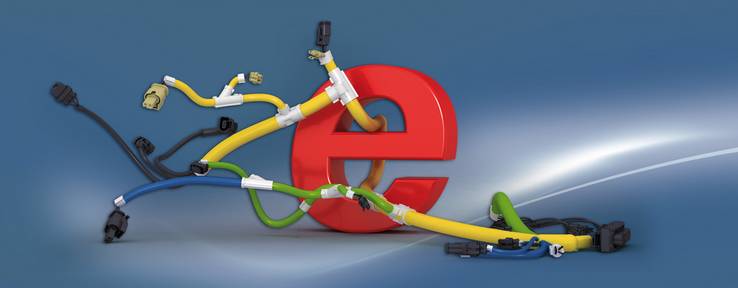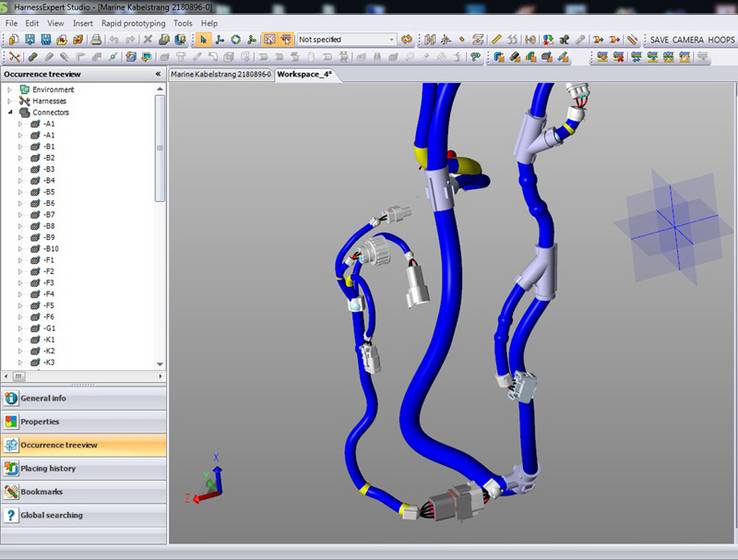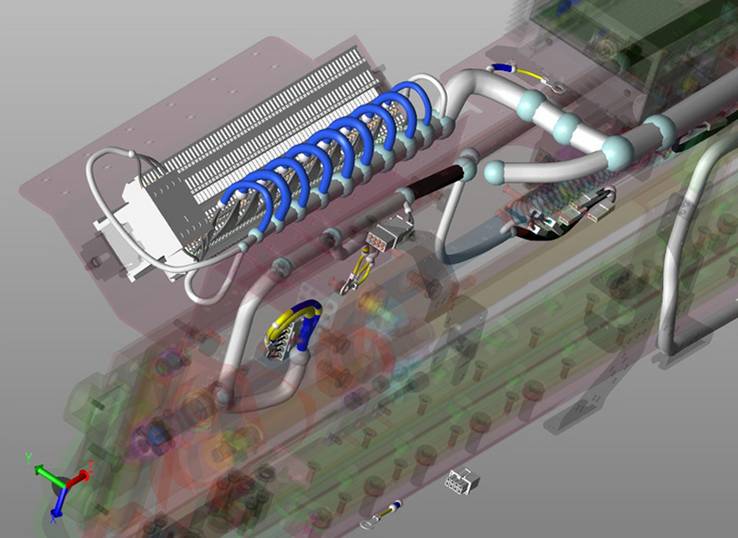EPLAN takes on the cable harness
Cable harnesses – EPLAN has previously been known for its electrical engineering and mechatronics applications, now the company is entering virgin territory with a cable harness software solution.
Individual conductors, i.e. individual cables are used in control cabinets, the design of which remains the central concern of the EPLAN software. There is, however, a trend towards decentralized control systems in machinery, which are then connected together by cable bundles or cable harnesses. Other areas of application are found in mechatronical products of all types’ right up to cars and aircraft. Cable harnesses are customized components which are customized to a high level. The times in which a car wiring harness included all possible cables, even if the relevant items of equipment were not fitted to the car are long past. Cable harnesses are adapted to the actual requirements more frequently and precisely, which leads to the design effort also growing correspondingly. On 1 July 2012, EPLAN acquired the development and sales rights for the Harness Expert software from Linius Technologies. At a press conference, EPLAN's CEO called Harness Expert “the only 3D solution in the cable harness business” capable of marrying 3D cable routing and electrical information. CAD and electrical data combined
EPLAN Harness proD contains the 3D data from a broad range of CAD systems to which corresponding interfaces are provided. Many CAD systems offer the capability of defining cable harnesses, but usually these 3D models are not accompanied by the electrical data, such as the number and diameter of the wires, for example. Harness proD closes this gap by importing the relevant information from EPLAN Electric P8 and processing it. The reverse trip is also possible; the 3D data for the cable harness defined in Harness proD can be posted back to the 3D system. On the one hand, this makes it possible to check the installation of the realistic cable harness in the complete model, in respect of diameter and bending capacity, for instance, and on the other hand, the 3D model can be kept as close to reality as possible. Harness proD also provides a 3D editor in which 3D models can be designed, if none already exists. The new software automatically generates from the 3D or 2D cable harness layout a whole series of reports required for calculations, ordering and production: complete or individual parts lists, connector and splice lists, wire and connection lists and reports concerning the operations to allow determination of time and costs. The data can be passed directly to wire make-up machines such as those manufactured by Komax. The system provides comprehensive practical testing and inspection functions for bending radii, rate of filling, cable lengths, bundles without wires and connectors to validate the wiring harness design. The installation of the cable harness in the product can also be simulated. The objective is to detect possible inconsistencies and errors early, i.e. before prototype production, making correction of such errors easy. The nail board drawing is the most important outcome of a cable harness design. Cable harnesses are generally put together by hand; a board carrying the drawing of the cable harness is used as a tool. Nails are driven in at the branches so that the individual conductors can be routed around these nails. The wires on the board are then wrapped in shrink tubing, fabric tape or tubing and put together to form the cable harness. The cable ends and the pin-out of the connector are shown in the drawing at the end of each stub so that there can be no misunderstandings during assembly. Harness proD helps the user in preparing the nail board drawing so that processing the three-dimensional harness into a 2D drawing requires just a few mouse clicks. The program has the information regarding cable colours and connectors from EPLAN Electric P8 anyway, so that it’s only necessary to arrange the illustrations of the connectors and their pin-outs on the drawing. From the control cabinet to the product
Maximilian Brandl underlined the importance of the cable harness in products by stating that the cable harness is the second most costly component in a car after the engine and gearbox unit. EPLAN is not just rounding off its product portfolio with Harness proD, but is also opening up new customer groups: whereas for many customers the company has previously been confined to the design of production equipment and automation, where control cabinets are being designed, the company has made the leap into product design with Harness proD. In many companies, cable harness design remains a manual process; although the cable harness is defined in the design process, this covers only its technical characteristics. The physical form of the cable harness is not defined until very late in the development process – with the concomitant time requirements and a significant potential for changes which might become necessary, for instance, if the cable harness is thicker than originally thought and a wall pass-through is suddenly too small, or in the wrong place. EPLAN has extended its portfolio with Harness proD and has cleverly positioned itself in with the existing customer companies. EPLAN Sales should have an easier ride with satisfied Electric customers in selling the Harness solution and optimizing cable harness design if the reference customer is its own automation department. But the unique selling point of 3D design will also make an impression on new customers – 3D modelling of the cable harness in all its facets, i.e. also including the information from electrical design, is really the only future-proofed method of working. Author: Ralf Steck, publsihed in :K CAD CAM, edition 6/12





